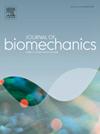Characterizing baseline fixed charge density in human cervical intervertebral discs
IF 2.4
3区 医学
Q3 BIOPHYSICS
引用次数: 0
Abstract
This study provides quantification of fixed charge density in human cervical intervertebral discs. Fixed charge density, which occurs due to negatively charged proteoglycans in the extracellular matrix, is a key determinant of the intervertebral disc osmotic environment and swelling properties. While regional fixed charge density patterns have been characterized in lumbar discs, they remain unexplored in cervical discs. Using fresh-frozen cadaveric cervical discs from five donors, fixed charge density was measured using a two-point electrical conductivity method. Glycosaminoglycan content and porosity were also assessed. Fixed charge density (0.18 ± 0.1 mEq/g wet tissue) was highest in the cartilage endplate region and significantly greater than in that in the annulus fibrosus (p = 0.006). No significant difference in fixed charge density was observed between the nucleus pulposus and annulus fibrosus. Glycosaminoglycan content (40.3 ± 14.4 µg/mg wet tissue) showed a strong positive correlation with fixed charge density across regions (r = 0.65, p = 0.0047). Unlike lumbar discs, fixed charge density was found to be more homogeneous between the nucleus pulposus and annulus fibrosus regions. This result likely reflects adaptations for reduced tissue swelling in cervical discs to accommodate lower weight-bearing demands and increased flexibility. The elevated fixed charge density in the cervical endplates may protect the intervertebral disc-vertebral bone interface, potentially to avoid mechanical damage in a kinematically more mobile environment. These findings establish key benchmarks for understanding cervical disc electro-biomechanics and may inform other cervical disc tissue-characterization efforts.
求助全文
约1分钟内获得全文
求助全文
来源期刊

Journal of biomechanics
生物-工程:生物医学
CiteScore
5.10
自引率
4.20%
发文量
345
审稿时长
1 months
期刊介绍:
The Journal of Biomechanics publishes reports of original and substantial findings using the principles of mechanics to explore biological problems. Analytical, as well as experimental papers may be submitted, and the journal accepts original articles, surveys and perspective articles (usually by Editorial invitation only), book reviews and letters to the Editor. The criteria for acceptance of manuscripts include excellence, novelty, significance, clarity, conciseness and interest to the readership.
Papers published in the journal may cover a wide range of topics in biomechanics, including, but not limited to:
-Fundamental Topics - Biomechanics of the musculoskeletal, cardiovascular, and respiratory systems, mechanics of hard and soft tissues, biofluid mechanics, mechanics of prostheses and implant-tissue interfaces, mechanics of cells.
-Cardiovascular and Respiratory Biomechanics - Mechanics of blood-flow, air-flow, mechanics of the soft tissues, flow-tissue or flow-prosthesis interactions.
-Cell Biomechanics - Biomechanic analyses of cells, membranes and sub-cellular structures; the relationship of the mechanical environment to cell and tissue response.
-Dental Biomechanics - Design and analysis of dental tissues and prostheses, mechanics of chewing.
-Functional Tissue Engineering - The role of biomechanical factors in engineered tissue replacements and regenerative medicine.
-Injury Biomechanics - Mechanics of impact and trauma, dynamics of man-machine interaction.
-Molecular Biomechanics - Mechanical analyses of biomolecules.
-Orthopedic Biomechanics - Mechanics of fracture and fracture fixation, mechanics of implants and implant fixation, mechanics of bones and joints, wear of natural and artificial joints.
-Rehabilitation Biomechanics - Analyses of gait, mechanics of prosthetics and orthotics.
-Sports Biomechanics - Mechanical analyses of sports performance.
 求助内容:
求助内容: 应助结果提醒方式:
应助结果提醒方式:


